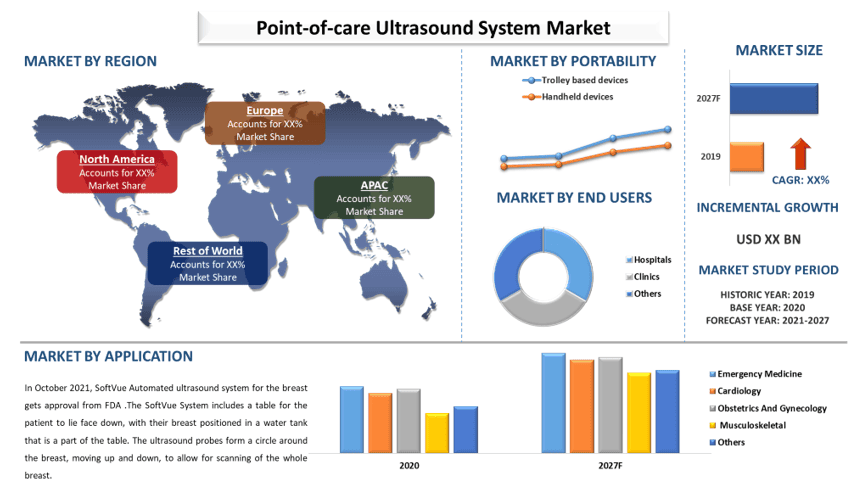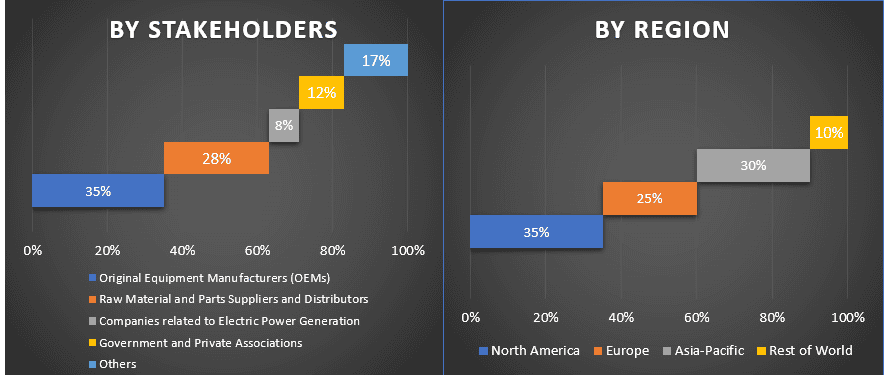- Home
- About Us
- Industry
- Services
- Reading
- Contact Us
Point-of-Care Ultrasound Device Market: Current Analysis and Forecast (2021-2027)
Emphasis on Portability (Trolley based devices and Handheld devices); Application (Emergency Medicine, Cardiology, Obstetrics And Gynecology, Musculoskeletal, And others) Type (Diagnostics And Therapeutics); End-users(Hospitals, Clinics, and Others); and Region/Country

The point-of-care ultrasound device market is predicted to grow at a CAGR of ~9% between 2021 and 2027. This is mainly due to the growing prevalence of diseases around the world, surging medical infrastructure developments in developing economies and developed countries, and increased awareness about diseases and their management around the world. Furthermore, the increasing elderly population and the adoption of speedy, accurate, and more portable diagnostics technology in emergency departments increase the demand for point-of-care ultrasound devices. Furthermore, the rising production and demand for medical devices also contribute to the market share for POCUS. In South Korea, for instance, according to Korea medical devices industry association, the market for medical devices increased by 43% between 2015 and 2019 which accounted for US$ 4,653 million in the former year and reached US$ 6,694 million in the latter year.
Abbott Laboratories, Siemens Healthineers AG, Quidel Corporation, F. Hoffman-La Roche Ltd., Danaher Corporation, Becton Dickinson and Company, Chembio Diagnostics, EKF Diagnostics, Trinity Biotech plc, Instrumentation Laboratory (a Werfen Company) are some of the prominent players operating in the Point-of-Care Ultrasound Device market. Several M&As along with partnerships have been undertaken by these players to facilitate customers with hi-tech and innovative products/technologies.
Insights Presented in the Report
“Amongst Portability, Trolley-Based Devices Category Held Significant Share in 2020”
Based on portability, the market is bifurcated into trolley-based devices and handheld devices. in 2020, trolley-based devices had a significant share. The dominance is due to the higher adoption of imaging techniques for diagnosis of diseases such as cardiovascular diseases and anesthetics. However, handheld devices are likely to dominate in the forecast period. The rising demand for better and portable devices by healthcare professionals contributes to the market growth of the point of contact ultrasound devices. Furthermore, the advancements in microchips and their significant use in medical devices enable the manufacturers to manufacture portable devices contributing to the segmental growth of the handheld devices.
“Amongst Application, Obstetrics & Gynecology Category to Witness Higher Incremental Gain During the Forecast Period”
On the basis of application, the market is categorized into emergency medicine, cardiology, obstetrics & gynecology, musculoskeletal, and others. Among them, in 2020, the obstetrics & gynecology segment held a considerable share and is anticipated to grow during the forecast period. The increasing number of pregnancies and related complexities highly contributed to the market share of the segment. For instance, as per WHO, globally obstructed labor is a major cause of maternal mortality, accounting for 1–5 deaths/1000 live births.
Amongst Types, Diagnostic Category Held Significant Share in 2020”
Based on types, the market has been bifurcated into diagnostics and therapeutics. In addition, the rising frequency of chronic disorders such as nephrolithiasis and cardiovascular diseases would lead to the diagnostic segments’ considerable market share in 2020. The segmental growth is due to the specialization of the diagnostic centers in the visualization and diagnosis along with the presence of skilled staff. Furthermore, the integration of advanced technology such as AI-based equipment and electronic patient records attributes to the growth of diagnostic imaging centers in the POCUS market. For instance, in India, Mahajan Imaging has launched an integrated center of excellence in diagnostics in Delhi to offer precision and personalized treatment to patients. The new center is equipped with an R&D department and an AI startup.
“Amongst End-user, Hospital segment Category to Witness Highest CAGR”
Based on end-users, the market is segmented into hospitals, clinics, and others. Among these, the hospital segment is predicted to have a major market share in the forecast period. The increasing number of surgeries is one of the major reasons for it. Furthermore, Hospitals complement and amplify the effectiveness of many other parts of the health system, providing continuous availability of services for acute and complex conditions. The unexpected increase in the emergency cases such as cardiac arrest, accidents, and traumas in the emergency department of the hospitals induces the demand for diagnostic devices in hospitals. Moreover, multiple uses of the POCUS in therapeutics and diagnostics have a positive impact on the growth of the hospital segment in the POCUS market.
“North America is expected to be the Fastest-Growing Region in Global Point-of-Care Ultrasound Device Market During 2021–2027F”
During the forecast period, North America is expected to have a higher CAGR due to extensive investment in healthcare expenditure by the developed nations such as U.S and Canada in the region. Furthermore, increasing focus government organizations and medical device companies are focusing on developing and launching advanced systems in the market. For instance, SoftVue Automated ultrasound system for the breast gets approval from FDA in October 2021. Additionally, favorable reimbursement and insurance regulations to proliferate the market growth during the forecast period.
Reasons to buy this report:
- The study includes market sizing and forecasting analysis validated by authenticated key industry experts
- The report presents a quick review of overall industry performance at one glance
- The report covers an in-depth analysis of prominent industry peers with a primary focus on key business financials, product portfolio, expansion strategies, and recent developments
- Detailed examination of drivers, restraints, key trends, and opportunities prevailing in the industry
- The study comprehensively covers the market across different segments
- Deep dive regional level analysis of the industry
Customization Options:
Point-of-Care Ultrasound Device market can further be customized as per the requirement or any other market segment. Besides this, UMI understands that you may have your own business needs, hence feel free to connect with us to get a report that completely suits your requirements.
Table of Content
Research Methodology for the Point-of-Care Ultrasound Device Market Analysis (2021-2027)
Analyzing the historical market, estimation of the current market, and forecasting the future market of the point-of-care ultrasound device market were the three major steps undertaken to create and analyze the adoption of point-of-care ultrasound device in major regions globally. Exhaustive secondary research was conducted to collect the historical market numbers and estimate the current market size. Secondly, to validate these insights, numerous findings and assumptions were taken into consideration. Moreover, exhaustive primary interviews were also conducted, with industry experts across the value chain of the point-of-care ultrasound device market. post assumption and validation of market numbers through primary interviews, we employed a top-down/bottom-up approach to forecasting the complete market size. Thereafter, market breakdown and data triangulation methods were adopted to estimate and analyze the market size of segments and sub-segments the industry pertains to. Detailed methodology is explained below:
Seek More Details About Research Methodology
Analysis of Historical Market Size
Step 1: In-Depth Study of Secondary Sources:
Detail secondary study was conducted to obtain the historical market size of the point-of-care ultrasound device through company internal sources such as annual report & financial statements, performance presentations, press releases, etc., and external sources including journals, news & articles, government publications, competitor publications, sector reports, third-party database, and other credible publications.
Step 2: Market Segmentation:
- After obtaining the historical market size of the point-of-care ultrasound device market, we conducted a detailed secondary analysis to gather historical market insights and share for different segments & sub-segments for major regions. Major segments included in the report as portability, application, and types. Further country-level analyses were conducted to evaluate the overall adoption of point-of-care ultrasound devices in that region.
Step 3: Factor Analysis:
After acquiring the historical market size of different segments and sub-segments, we conducted a detailed factor analysis to estimate the current market size of a point-of-care ultrasound device. further, we conducted factor analysis using dependent and independent variables such as the increasing digitalization of industries and urbanization in developing countries. a thorough analysis was conducted for demand and supply-side scenarios considering top partnerships, mergers and acquisitions, business expansion, and product launches in the point-of-care ultrasound device sector across the globe.
Current Market Size Estimate & Forecast
Current Market Sizing: Based on actionable insights from the above 3 steps, we arrived at the current market size, key players in the point-of-care ultrasound device market, and market shares of the segments. All the required percentage shares split, and market breakdowns were determined using the above-mentioned secondary approach and were verified through primary interviews.
Estimation & Forecasting: For market estimation and forecast, weights were assigned to different factors including drivers & trends, restraints, and opportunities available for the stakeholders. After analyzing these factors, relevant forecasting techniques i.e., the top-down/bottom-up approach were applied to arrive at the market forecast about 2027 for different segments and subsegments across the major markets globally. The research methodology adopted to estimate the market size encompasses:
- The industry’s market size, in terms of value (US$) and the adoption rate of point-of-care ultrasound devices across the major markets domestically
- All percentage shares, splits, and breakdowns of market segments and sub-segments
- Key players in the point-of-care ultrasound device market in terms of products offered. Also, the growth strategies adopted by these players to compete in the fast-growing market
Market Size and Share Validation
Primary Research: In-depth interviews were conducted with the Key Opinion Leaders (KOLs) including Top Level Executives (CXO/VPs, Sales Head, Marketing Head, Operational Head, Regional Head, Country Head, etc.) across major regions. Primary research findings were then summarized, and statistical analysis was performed to prove the stated hypothesis. Inputs from primary research were consolidated with secondary findings, hence turning information into actionable insights.
Split of Primary Participants in Different Regions

Market Engineering
Data triangulation technique was employed to complete the overall market estimation and to arrive at precise statistical numbers of each segment and sub-segment of the point-of-care ultrasound device market. Data was split into several segments & sub-segments post studying various parameters and trends in the areas of portability, application, and types of the point-of-care ultrasound device market.
The main objective of the Point-of-Care Ultrasound Device Market Study
The current & future market trends of point-of-care ultrasound device were pinpointed in the study. investors can gain strategic insights to base their discretion for investments from the qualitative and quantitative analysis performed in the study. Current and future market trends were determined the overall attractiveness of the market at a regional level, providing a platform for the industrial participant to exploit the untapped market to benefit as a first-mover advantage. Other quantitative goals of the studies include:
- Analyze the current and forecast market size of the point-of-care ultrasound device in terms of value (us$). also, analyze the current and forecast market size of different segments and sub-segments
- Segments in the study include areas of portability, application, and types.
- Define and analysis of the regulatory framework for the point-of-care ultrasound device industry
- Analyze the value chain involved with the presence of various intermediaries, along with analyzing customer and competitor behaviors of the industry
- analyze the current and forecast market size of the point-of-care ultrasound device market for the major region
- Major regions studied in the report include North America (U.S, Canada, and Rest of North America), Europe (Germany, United Kingdom, France, Spain, Italy, and Rest of Europe), Asia-Pacific (China, Japan, India, South Korea, and Others), and the Rest of the World
- Company profiles of the point-of-care ultrasound device market and the growth strategies adopted by the market players to sustain in the fast-growing market
- Deep dive regional level analysis of the industry
Related Reports
Customers who bought this item also bought










